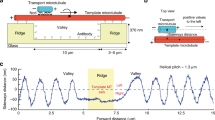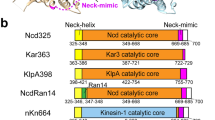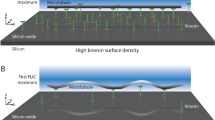Abstract
To understand the mechanism of kinesin movement we have investigated the relative configuration of the two kinesin motor domains during ATP hydrolysis using fluorescence polarization microscopy of ensemble and single molecules. We found that: (i) in nucleotide states that induce strong microtubule binding, both motor domains are bound to the microtubule with similar orientations; (ii) this orientation is maintained during processive motion in the presence of ATP; (iii) the neck-linker region of the motor domain has distinct configurations for each nucleotide condition tested. Our results fit well with a hand-over-hand type movement mechanism and suggest how the ATPase cycle in the two motor domains is coordinated. We propose that the motor neck-linker domain configuration controls ADP release.
This is a preview of subscription content, access via your institution
Access options
Subscribe to this journal
Receive 12 print issues and online access
$189.00 per year
only $15.75 per issue
Buy this article
- Purchase on Springer Link
- Instant access to full article PDF
Prices may be subject to local taxes which are calculated during checkout





Similar content being viewed by others
References
Goldstein, L.S.B. & Philp, A.V. The road less traveled: emerging principles of kinesin motor utilization. Annu. Rev. Cell Dev. Biol. 15, 141–183 (1999).
Howard, J., Hudspeth, A.J. & Vale, R.D. Movement of microtubules by single kinesin molecules. Nature 342, 154–158 (1989).
Hackney, D.D. Evidence for alternating head catalysis by kinesin during microtubule-stimulated ATP hydrolysis. Proc. Natl. Acad. Sci. USA 91, 6865–6869 (1994).
Kawaguchi, K. & Ishiwata, S. Nucleotide-dependent single- to double-headed binding of kinesin. Science 291, 667–669 (2001).
Hirose, K., Lockhart, A., Cross, R.A. & Amos, L.A. Three-dimensional cryoelectron microscopy of dimeric kinesin and ncd motor domains on microtubules. Proc. Natl. Acad. Sci. USA 93, 9539–9544 (1996).
Arnal, I., Metoz, F., DeBonis, S. & Wade, R.H. Three-dimensional structure of functional motor proteins on microtubules. Curr. Biol. 6, 1265–1270 (1996).
Hoenger, A. et al. Image reconstructions of microtubules decorated with monomeric and dimeric kinesins: comparison with X-ray structure and implications for motility. J. Cell Biol. 141, 419–430 (1998).
Peterman, E.J., Sosa, H., Goldstein, L.S. & Moerner, W.E. Polarized fluorescence microscopy of individual and many kinesin motors bound to axonemal microtubules. Biophys. J. 81, 2851–2863 (2001).
Sosa, H., Peterman, E.J., Moerner, W.E. & Goldstein, L.S. ADP-induced rocking of the kinesin motor domain revealed by single-molecule fluorescence polarization microscopy. Nat. Struct. Biol. 8, 540–544 (2001).
Rice, S. et al. A structural change in the kinesin motor protein that drives motility. Nature 402, 778–784 (1999).
Wittinghofer, A. Signaling mechanistics: aluminum fluoride for molecule of the year. Curr. Biol. 7, R682–R685 (1997).
Crevel, I.M., Lockhart, A. & Cross, R.A. Weak and strong states of kinesin and ncd. J. Mol. Biol. 257, 66–76 (1996).
Sosa, H. et al. A model for the microtubule-Ncd motor protein complex obtained by cryo-electron microscopy and image analysis. Cell 90, 217–224 (1997).
Kikkawa, M. et al. Switch-based mechanism of kinesin motors. Nature 411, 439–445 (2001).
Sack, S. et al. X-ray structure of motor and neck domains from rat brain kinesin. Biochemistry 36, 16155–16165 (1997).
Kozielski, F. et al. The crystal structure of dimeric kinesin and implications for microtubule-dependent motility. Cell 91, 985–994 (1997).
Hua, W., Young, E.C., Fleming, M.L. & Gelles, J. Coupling of kinesin steps to ATP hydrolysis. Nature 388, 390–393 (1997).
Coy, D.L., Wagenbach, M. & Howard, J. Kinesin takes one 8-nm step for each ATP that it hydrolyzes. J. Biol. Chem. 274, 3667–3671 (1999).
Schnitzer, M.J. & Block, S.M. Kinesin hydrolyses one ATP per 8-nm step. Nature 388, 386–390 (1997).
Ma, Y.Z. & Taylor, E.W. Interacting head mechanism of microtubule-kinesin ATPase. J. Biol. Chem. 272, 724–730 (1997).
Gilbert, S.P., Moyer, M.L. & Johnson, K.A. Alternating site mechanism of the kinesin ATPase. Biochemistry 37, 800–813 (1998).
Schief, W.R. & Howard, J. Conformational changes during kinesin motility. Curr. Opin. Cell Biol. 13, 19–28 (2001).
Vale, R.D. & Milligan, R.A. The way things move: looking under the hood of molecular motor proteins. Science 288, 88–95 (2000).
Jiang, W., Stock, M.F., Li, X. & Hackney, D.D. Influence of the kinesin neck domain on dimerization and ATPase kinetics. Biochemistry 37, 5288–5295 (1997).
Gibbons, I.R. & Fronk, E. A latent adenosine triphosphatase form of dynein 1 from sea urchin sperm flagella. J. Biol. Chem. 254, 187–196 (1979).
Pierce, D.W. & Vale, R.D. Assaying processive movement of kinesin by fluorescence microscopy. Methods Enzymol. 298, 154–171 (1998).
Lakowicz, J.R. Principles of Fluorescence Spectroscopy (Kluwer Academic, Plenum Publishers, New York, 1999).
Corrie, J.E.T. et al. Dynamic measurement of myosin light-chain-domain tilt and twist in muscle contraction. Nature 400, 425–430 (1999).
Acknowledgements
We thank G. Rogers, D. Sharp, D. Buster and M. Akabas for discussions and critical reading of the manuscript, H. Deng for mass spectrometry analysis and E. Peterman for experimental advice and discussions. This project was supported by a US National Institutes of Health grant to H.S.
Author information
Authors and Affiliations
Corresponding author
Ethics declarations
Competing interests
The authors declare no competing financial interests.
Supplementary information
Rights and permissions
About this article
Cite this article
Asenjo, A., Krohn, N. & Sosa, H. Configuration of the two kinesin motor domains during ATP hydrolysis. Nat Struct Mol Biol 10, 836–842 (2003). https://doi.org/10.1038/nsb984
Received:
Accepted:
Published:
Issue Date:
DOI: https://doi.org/10.1038/nsb984
This article is cited by
-
Six-dimensional single-molecule imaging with isotropic resolution using a multi-view reflector microscope
Nature Photonics (2023)
-
Shaft Function of Kinesin-1’s α4 Helix in the Processive Movement
Cellular and Molecular Bioengineering (2019)
-
Anchor Effect of Interactions Between Kinesin’s Nucleotide-Binding Pocket and Microtubule
Cellular and Molecular Bioengineering (2017)
-
Detectable states, cycle fluxes, and motility scaling of molecular motor kinesin: An integrative kinetic graph theory analysis
Frontiers of Physics (2017)
-
Direct observation of intermediate states during the stepping motion of kinesin-1
Nature Chemical Biology (2016)



